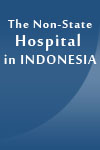Tahun 2005 - Sebelumnya
Undang -Undang Tahun 2005 - Sebelumnya
Undang-Undang No. 1 Tahun 2004 ttg Perbendaharaan Negara
Undang-Undang No. 10 Tahun 2004 ttg Pembentukan Peraturan Perundang-undangan
Undang-Undang No. 23 Tahun 2004 ttg Penghapusan Kekerasan dalam Rumah Tangga
Undang-Undang No. 29 Tahun 2004 ttg Praktik Kedokteran
Undang-Undang No. 40 Tahun 2004 ttg Sistem Jaminan Sosial Nasional
Undang-Undang No. 13 Tahun 2003 ttg Ketenagakerjaan
Undang-Undang No. 17 Tahun 2003 ttg Keuangan Negara
Undang-Undang No. 18 Tahun 2002 ttg Sistem Nasional Penelitian Pengembangan dan Rencana IPTEK
Undang-Undang No. 24 Tahun 2000 ttg Perjanjian Internasional
Undang-Undang No. 5 Tahun 1997 ttg Psikotropika
Keputusan Presiden 2005 - Sebelumnya
Keppres No. 80 Th 2003 ttg Pedoman Pelaksanaan Pengadaan Barang-Jasa Pemerintah
Keppres No. 12 Th 1994 ttg Badan Pertimbangan Kesehatan Nasional
Keppres No. 23 Th 1994 ttg Pengangakatan Bidan sebagai Pegawai Tidak Tetap
Keppres No. 56 Th 1995 ttg Majelis Disiplin Tenaga Kerja
Keputusan Menteri Kesehatan 2005 - Sebelumnya
KMK 867-2004 REGISTRASI DAN PRAKTIK TERAPIS WICARA
KMK 640-2003 TEKNISI KARDIOVASKULER
KMK 544-2002 REGISTRASI DAN IZIN KERJA REFRAKSIONIS OPTISIEN
KMK 900_2002 REGISTRASI DAN PRAKTIK BIDAN
KMK 1239_2001 REGISTRASI DAN PRAKTIK PERAWAT
KMK 1392-2001 REGISTRASI DAN IZIN KERJA PERAWAT GIGI
Petunjuk Audio Streaming
Petunjuk untuk mengikuti kegiatan audio streaming :
- Siaran Audio live streaming bisa Anda dengarkan secara langsung pada setiap acara yang disiarkan secara live dari website ini.
- Setiap kegiatan yang disiarkan secara live streaming sudah terjadwal dan dapat dilihat di website http://kebijakankesehatanindonesia.net.
- Untuk mendengarkan silahkan klik tombol PLAY, dan untuk berhenti silahkan tekan tombol PAUSE. Untuk lebih detailnya silahkan lihat gambar berikut
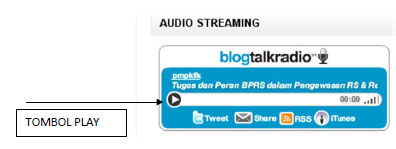
- Jika anda ingin ikut berpartisipasi (bertanya atau memberikan opini), Anda bisa menelpon ke nomor telepon yang kami sediakan pada saat acara berlangsung.
- Setiap agenda audio live streaming akan ditampilkan di bawah Media player audio streaming di website kami.
- Arsip Audio Streaming bisa diakses di http://blogtalkradio.com/pmpkfk
- Sebagai catatan: Jika Anda menggunakan laptop, disarankan Anda menggunakan headset saat mendengarkan live audio streaming agar kualitas suara terdengar jelas dan tidak terjadi feedback. Jika anda menggunakan PC anda dapat menggunakan speaker untuk didengarkan bersama-sama.
- Jika Anda butuh bantuan teknis mengenai audio live streaming anda dapat berkonsultasi langsung ke no 0274 580 442
Tahun 2011
Publikasi
Publikasi World Bank
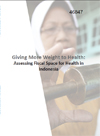 |
|
 |
|
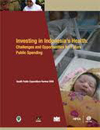 |
Investing in Indonesia’s Health: Challenges and Opportunities for Future Public Spending |
 |
Publikasi Buku
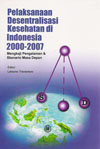 |
Pelaksanaan Desentralisasi Kesehatan di Indonesia 2000 - 2007 oleh : Prof. dr. Laksono Trisnantoro, MSc, Ph.D |
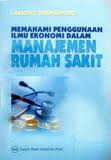 |
Memahami Penggunaan Ilmu Ekonomi dalam Manajemen Rumah Sakit oleh : Prof. dr. Laksono Trisnantoro, MSc, Ph.D |
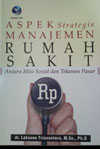 |
Aspek Strategis Manajemen Rumah Sakit oleh : Prof. dr. Laksono Trisnantoro, MSc, Ph.D |
Publikasi Lainnya
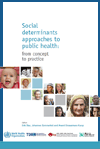 |
Social Determinants Approaches to Public Health oleh : World Health Organisation |
"Developing Good Taste in Evidence?
Aspek Strategis Manajemen Rumah Sakit

Prof. dr. Laksono Trisnantoro, M.Sc., Ph.D
Bagian 1 Lingkungan dan Strategi RS
- BAB I - DINAMIKA LINGKUNGAN USAHA RUMAH SAKIT
- BAB II - PRINSIP-PRINSIP MANAJEMEN STRATEGIS
- BAB III - BUDAYA ORGANISASI DAN MANAJEMEN STRATEGIS
Bagian 2 Rencana Strategis dan Kepemimpinan
- BAB IV - SIFAT LEMBAGA RUMAH SAKIT
- BAB V - PERENCANAAN STRATEGIS DAN KEPEMIMPINAN
Bagian 3 Visi dan Strategi
- BAB VI - MISI DAN VISI RUMAH SAKIT
- BAB VII - ANALISIS EKSTERNAL DAN INTERNAL
- BAB VIII - PERUMUSAN STRATEGI DAN PROGRAM
- BAB IX - STRATEGI PENGGALIAN SUMBER DANA RUMAH SAKIT UNTUK FUNGSI SOSIAL
Bagian 4 Isu pengembangan RS
- BAB X - PERKEMBANGAN TEKNOLOGI, PENGARUH PASAR, DAN PERILAKU PROFESIONAL
- BAB XI - GOVERNANCE DI SEKTOR RUMAH SAKIT
Peraturan Perundangan 2009
Undang - Undang
Undang-Undang No. 11 Tahun 2009 ttg Kesejahteraan Sosial
Undang-Undang No. 25 Tahun 2009 ttg Pelayanan Publik
Undang-Undang No. 35 Tahun 2009 ttg Narkotika
Undang-Undang No. 36 Tahun 2009 ttg Kesehatan
Undang-Undang No. 43 Tahun 2009 ttg Kearsipan
Undang-Undang No. 44 Tahun 2009 ttg Rumah Sakit
Undang-Undang No. 52 Tahun 2009 ttg Perkembangan Kependudukan dan Pembangunan Keluarga


